It’s not every day you have to take your top off in front of a prince, even in the line of duty.
Sophie Rhys-Jones wasn’t shy, but she admitted to being a ‘bit nervous’ when she was unexpectedly called in to help launch a charity challenge fronted by Prince Edward in the summer of 1993.
Tennis player and presenter Sue Barker has been booked to provide some celebrity glamour, the idea being she would pose for a series of pictures with the prince – the more daring the better.
To raise money for the Duke of Edinburgh‘s award scheme, the campaign encouraged people to take up a sponsored challenge, and Edward, 29, planned to lead the way by playing real tennis (the racquet sport from which the modern game derives) for as long as possible at Queen’s Club in West London.
At the last moment, Barker had to pull out of their photocall – and Sophie, an attractive young member of the PR team for the project, was asked to step in. She just had time to dash to her nearby flat and slip on a leotard.
For the next two hours, she swapped shirts and leant on the royal shoulder in a refreshingly natural manner (Edward tactfully looking away as she changed). The subsequent pictures showed Edward in his neatly pressed white tennis shorts, grinning from ear to ear.
No one noticed any electricity between them: Sophie, 28, simply told friends that Edward seemed like a ‘nice guy’.
In September, on the day of the challenge itself, photographers turned up hoping for a shot of Edward with his girlfriend, West End star Ruthie Henshall, not knowing they had already split up. If anyone had known what was on Edward’s mind, all lenses would have been trained on Sophie.
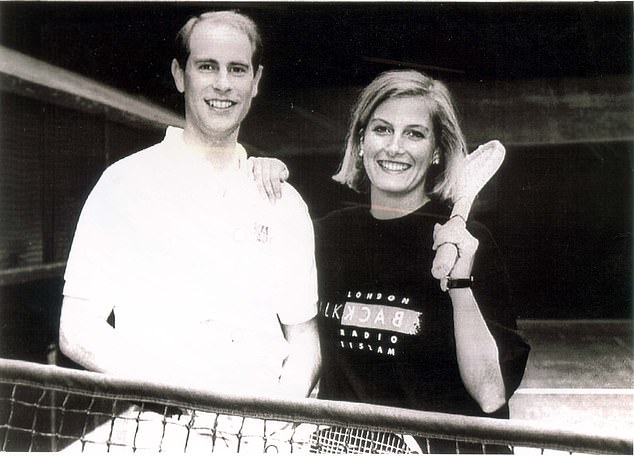
Edward and Sophie first met at a charity launch in 1993
A little while later, out of the blue one evening, Sophie’s phone rang. You can imagine her surprise at hearing Prince Edward’s voice. They chatted about the challenge, then Edward suggested she might like to join him for a game of real tennis and perhaps a bite of supper at the Palace.
More than 30 years later, they are still together – and, remarkably, this unassuming girl from a loving, stable but very ordinary middle-class home has come to play a central role in the Royal Family.
Poised, natural and not overly posh, she became a favourite of the late Queen – whom she addressed as Mama – and is now viewed by the royals as a trusted representative who can be relied upon never to put a foot wrong.
It hasn’t always been easy. As a commoner, with little support Sophie had to navigate the pitfalls of royal protocol, evade the paparazzi, try to balance a career with royal duty – something that ultimately proved impossible – all the while facing open hostility from Princess Diana, who cast her as a rival. Yet, of the Queen’s four children, Prince Edward is the only one still married to his original spouse. Sophie has proved not just that she has staying power – but grit.
On that very first date, the prince suggested Sophie might call him Edward rather than ‘Sir’. Over supper prepared by Edward’s valet – laid out as a buffet on a small card table in Edward’s second-floor suite at Buckingham Palace – they found common ground in their mutual love of theatre.
Edward, who had worked for Andrew Lloyd Webber as a production assistant, told Sophie about his first role as Mole in a school production of Toad Of Toad Hall. The Queen was in the audience and apparently loved it. Sophie recalled her first role in which she played a cockerel and treated Edward to her impression of a rooster awakening.
Sophie had the gift of making men feel at ease and Edward was no exception. When his friend, the producer Peter Brown, subsequently had dinner with them, he was struck by their similar sense of humour.
If they had made a list of the things they enjoyed it would have included movies, skiing, sailing, swimming and walking in wellington boots.
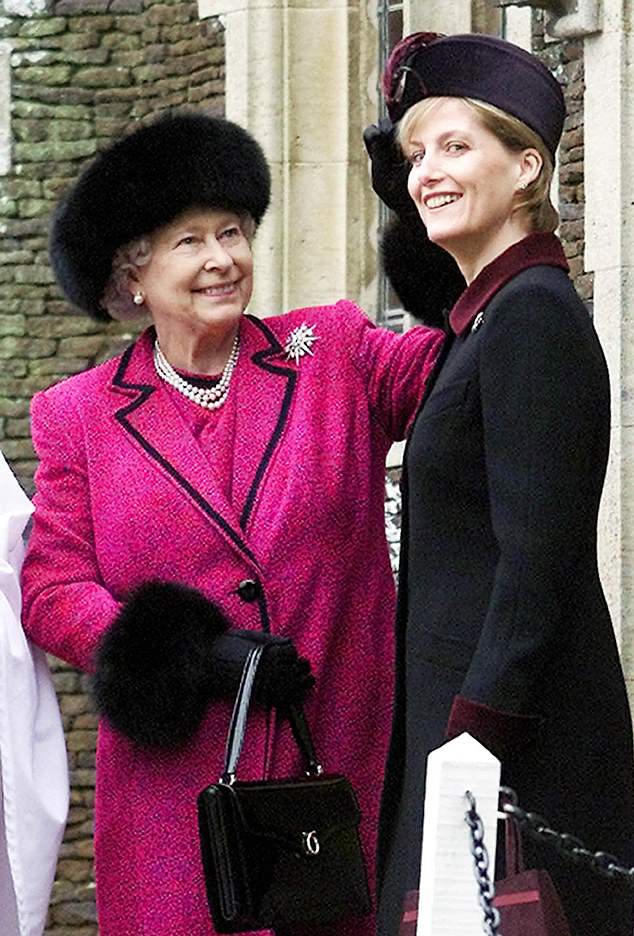
Poised, natural and not overly posh, Sophie became a favourite of the late Queen
Sophie was the more social – she had masses of friends, had lived and worked in Australia and enjoyed a drink. Edward, serious and quiet, had decided he wanted to see her again even before he asked his chauffeur to drive her home from their first date.
The new romance was confided to close friends and family only (Sophie’s father Christopher said that discovering his daughter was going out with Prince Edward was ‘the first time in my life that I needed a gin and tonic before ten o’clock’), but Sophie’s colleagues at work soon clocked the frequent calls for her from a man going by the name of ‘Richard’ or ‘Gus’.
But for a while at least, they were able to fly under the radar.
Edward took Sophie to an Indian restaurant he’d discovered when part of the team working for Lloyd Webber. They swam together in the private Buckingham Palace pool. ‘If the Queen walks in, do I have to curtsy underwater?’ Sophie asked Edward.
He thought this was hilarious – but she must have been intimidated by the thought that, sooner or later, she would have to meet his mother.
She practised her curtsy and asked her flatmate Ulli von Herwarth, a German aristocrat, to teach her how to use solid silver cutlery.
In early 1994, Edward suggested they spend the weekend at Windsor Castle, calmly reassuring her that the Queen would be leaving as they arrived, so there was no need to worry about meeting her – a small white lie that members of the Royal Family habitually employed to spare guests the nervous agony of wondering what to say when faced with Her Majesty.
Sophie drove herself to Windsor in her clapped-out Fiat Panda and parked in the courtyard near Edward’s apartment.
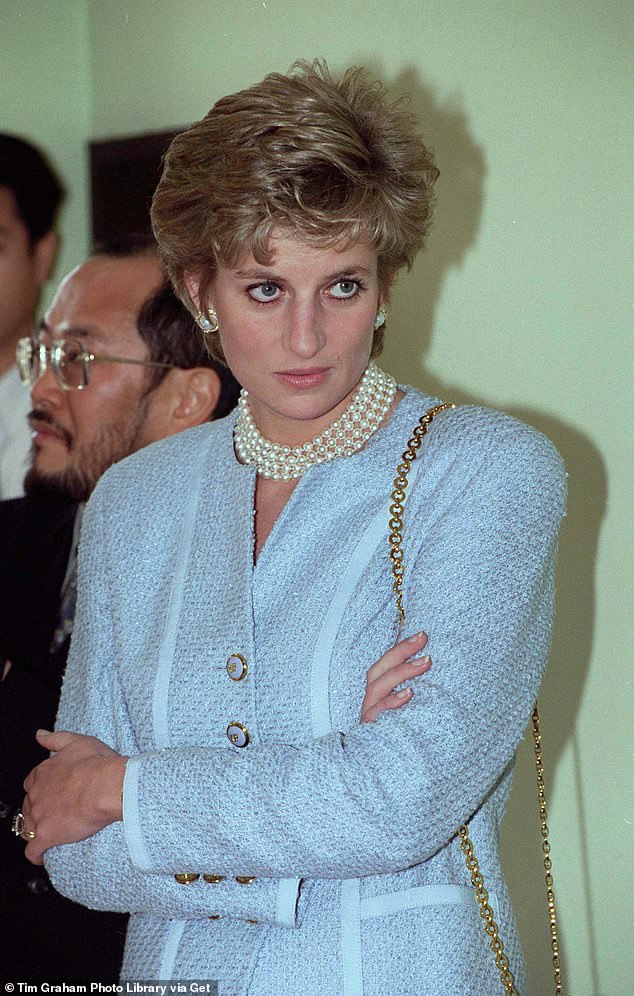
Diana, Princess of Wales – was not at all happy to welcome Sophie into the royal fold
As many young women would have done, she brought most of her wardrobe with her, so she was prepared for any eventuality. That was a good move: Edward bounced in to announce they were going riding.
At the last minute his valet informed her that the Queen would be at lunch after all, and as they walked in, Edward introduced her. There was a brief handshake and curtsy: all that practising at home had been worth it.
The lunch itself was a blur. Sophie was seated between Prince Philip and Princess Anne’s husband Tim Laurence, but took no part in the conversation. She was smart enough to know that the way to make a good impression in this company was to keep her mouth firmly shut.
The most important task was making sure there were no disasters while serving herself from the dishes offered by the squad of butlers.
The only thing she later recalled about the entire encounter was the Queen, then aged 67, dashing over to the window to watch Concorde fly over, dutifully followed by the rest of the family as if they had never seen the iconic plane’s silhouette before.
That afternoon, she and Edward bumped into Prince Andrew and Sarah Ferguson, who were bringing the Queen’s two granddaughters, Beatrice, five, and Eugenie, three, for tea. The couple had formally separated by then but did not divorce until May 1996.
Sophie was invited to join them and found that the Queen as grandma was a far less daunting prospect. For the first time she chatted politely with Edward’s mother.
The Queen was later heard to say of Sophie: ‘You wouldn’t notice her in a crowd.’ But that judgment is nowhere near as unflattering as it sounds. The last thing the royals needed just then was someone who would make headlines.
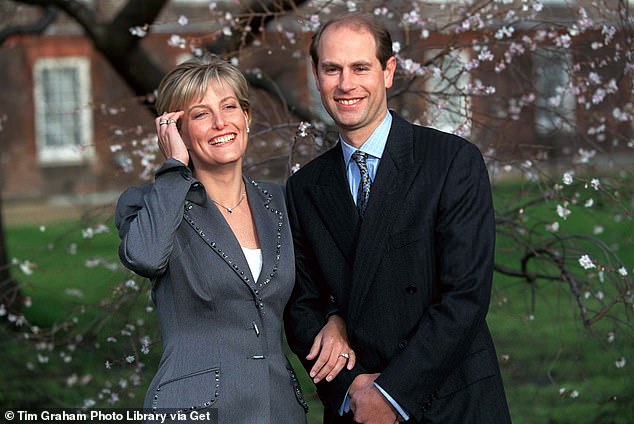
Edward and Sophie announced their engagement in January 1999
The previous few years had seen scandal piled on scandal: Andrew and Sarah had separated and so had Charles and Diana; Princess Anne had divorced; The Sun had published ‘Squidgygate’, details of a phone call between Diana and a lover, James Gilbey; Sarah had been caught in the ‘toe-sucking’ scandal, photographed topless and kissing her ‘financial adviser’ John Bryan; and a fire had damaged the royal apartments at Windsor – 1992 was so bad the Queen declared it her ‘annus horribilis’.
So it was greatly to Sophie’s advantage to maintain a low profile. She would have to face intense media scrutiny herself in the future, but for the moment she could quietly establish herself as a dependable presence. Both the Queen and Prince Philip seemed delighted that their youngest child had found someone genuinely nice.
On her second visit to Windsor, she was introduced to the Queen Mother and was invited to join both her and the Queen in the Royal Family’s private pews for the Sunday church service at St George’s Chapel.
So far, so good. But one person – Diana, Princess of Wales – was not at all happy to welcome Sophie into the royal fold, especially after a charity evening she hosted made 11 pages in Hello magazine, with Sophie, looking very glamorous in a bottle-green, floor-length velvet gown, chatting and dancing with Edward. Sophie came across as beautiful and fun.
The polite description of their relationship, as preferred by the more diplomatic of Sophie’s friends, was to say that there was ‘no love lost’ between the two women. Nothing summed up the situation better than what began as an innocuous afternoon tea with the Queen at Windsor Castle, attended by both Sophie and Diana, who came with her children, William and Harry.
Every time an animated Sophie started to say something, Diana would begin speaking, which meant that Sophie had to stop – it is a tradition that if a more senior royal starts talking, the junior royal has to keep quiet.
After what seemed like an age of being silenced by Diana, Sophie could stand no more and, having obtained the Queen’s permission to leave, strode back to Edward’s apartment seething with rage.
On another occasion she ran back to the apartment in floods of tears after a dinner at which Diana spent the whole time blatantly and intently staring at her.
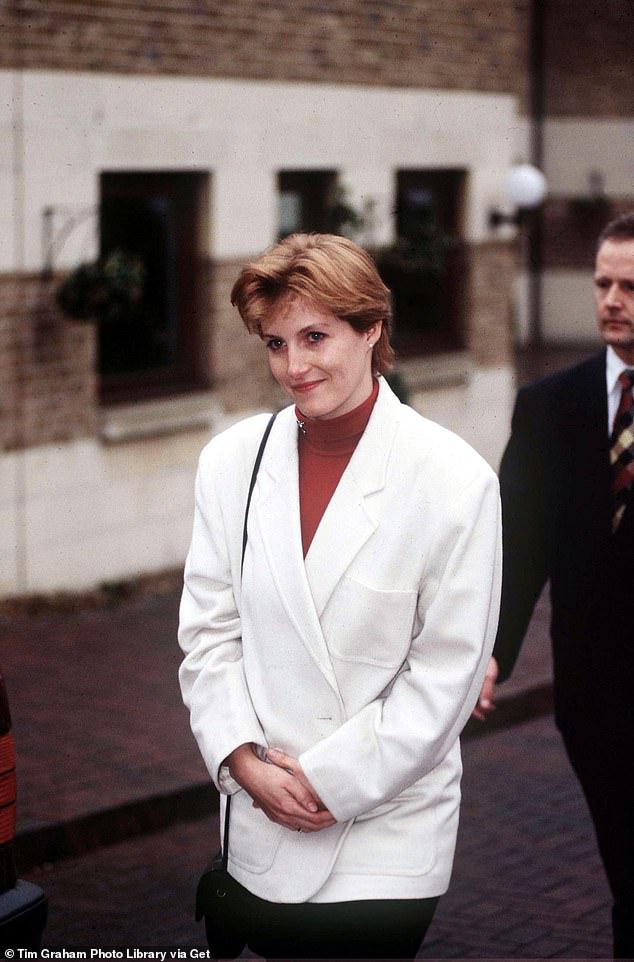
The most obvious difference was money. Diana, a multi-millionairess, had it in sack loads and Sophie did not
Sophie would do her utmost to avoid Diana if she possibly could.
The Princess of Wales had a strongly held view that no commoner could possibly survive within the cold steel embrace of the Royal Family and was not happy that Sophie, an ordinary girl from Kent, might succeed where she, an authentic aristocrat, had so abjectly failed.
Diana and Sophie were both outsiders, but they were light years apart.
The most obvious difference was money. Diana, a multi-millionairess, had it in sackloads and Sophie did not. She had to do her best on £25,000 a year – her salary at MCM, the PR agency where she still worked. Diana would spend six times that per annum on clothes alone.
Sophie was not stupid enough to become involved in a fashion contest with Diana, knowing she would trail a poor second.
She was happiest wrapping up in sensible clothes for a walk in the countryside; Diana would pop on a designer dress for the walk from her car to the entrance of her favourite restaurant, San Lorenzo, in Knightsbridge. Sophie could do a very passable imitation of her nemesis – the clipped vowels and the Bambi look at the camera that were so much in evidence in the notorious 1995 Panorama interview.
One of the reasons Sophie’s impression of Diana was so good is that they bore more than a passing resemblance to one another. When Diana saw Sophie approaching at some function, she would be heard to utter: ‘Oh, here comes my double.’ Or, less politely: ‘Here comes Miss Goody Two Shoes.’
Although Edward and Sophie spoke privately of marriage, there never seemed to be a good time to announce their engagement.
Diana’s Panorama interview caused huge shockwaves. Edward was adamant that when he announced his good news, it could not be part of a ploy to use good headlines to counter bad.
Thus, he rejected plans to announce their betrothal when Charles and Diana decided to divorce and later when Diana was stripped of her HRH title.
Staging a lavish celebratory wedding would have been unthinkable in the wake of Diana’s tragic death in 1997, so it was January 1999 when Edward and Sophie’s engagement was officially announced. They finally married that summer.
But less than two years later, Sophie would be fighting for her life.
- Adapted from Sophie: Saving The Royal Family, by Sean Smith (Sphere, £25), to be published July 17. To order a copy for £22.50 (offer valid to 26/07/25; UK P&P free on orders over £25) go to mailshop.co.uk/books or call 020 3176 2937.












